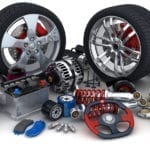Whether or not we are willing to accept it, winter is here. Some of the United States may have thought they were getting off easy, but lo and behold, old Mother Nature still reared her snowy head. With temperatures plummeting and snow piling high, vehicles end up taking the brunt of adverse weather conditions. Despite December and January already behind us, we still have a few more solid months left of winter weather. We may want to hold on to the thought that spring is only a few short weeks away, but that wishful thinking will only serve to distract us from what we need to do to protect our valuable investments.
If you haven’t done so already, it is important that you take steps to ensure your car is ready to tackle the rest of winter. From getting a synthetic oil change, to making sure your tires are in tip-top shape, there are plenty of things you can be doing to protect and winterize your car for 2016.
What Does “Winterizing” Actually Mean?
The word itself can be intimidating. Winterize. Is that even a word? We can say with complete confidence, that winterize is indeed a word. Not only is it included in the Webster Dictionary, it is also a term that every vehicle owner should be familiar with. Unless you happen to live in southern California or Florida, then winterize is a term you should add to the permanent list of words in your vocabulary.
Now that we have established that winterizing your vehicle is a real thing, let’s talk about exactly what it means. Essentially, cold weather and snow can cause major damage to your vehicle. Salt build up from the road can wreak havoc on your exterior paint job, as well as the axle and other components underneath the vehicle. Winterizing your car means preparing it for these harsh weather and road conditions, to help keep your vehicle protected from any potential damage it can cause.
Winter Weather: How it Can Ruin Your Car
It may not seem like a common occurrence, but winter weather can ruin your vehicle, severely limiting the lifespan of the engine, battery, and other essential components.
Large snow accumulations can end up rusting the brake lines in your vehicle, while the cold weather can cause your engine to overheat in an attempt to warm up too quickly. Salt treatments on roadways is essential to keeping vehicles safely on the road, but the harshness of this element can prove to be very detrimental to your car.
Rather than ruining your car this winter by convincing yourself the cold weather is almost over with, we have compiled a list of things you can do at home to help defend your car against the fury of winter, and things that your service technician can take care of on your next oil change visit.
Steps to Take to Winterize Your Vehicle
Don’t wait until it’s too late to make changes to your vehicle. These simple precautionary measures can easily be done at home or at your local certified service center.
-
Check Oil Levels:
Pop open your car’s hood and check to see if the oil level is at an appropriate level. If you live a in area of the United States that regularly experiences temperatures below freezing, then have your oil switched out with a thinner less viscous oil blend. Your local service center will be able to help you with this, ensuring that it is done properly and effectively.
-
Check Tire Tread:
Take a look at all four of the tires on your car and inspect how good the tread is. This is especially important if your vehicle is over five years old and the tires are original to the vehicle. The owner’s manual that came with your car will give you specific instructions on how to check the tires that came on your vehicle. If the tread is wearing down, and you live in a climate where heavy snow is a common occurrence, then you may want to consider purchasing snow tires for the remaining winter months. Snow tires offer better grip on the road and will help keep your vehicle on its intended path.
-
Check for Tire Pressure Fluctuations:
If you have ever brought a balloon from a warm indoor setting to a cold exterior location, then you know that cold air causes reduced inflation. Balloons aren’t the only victims of cold air deflation – your tires are also a main target. Regularly check your vehicle’s tire pressure, especially when the temps drop below freezing.
-
Check Your Windshield Wiper Blades:
Windshield wiper blades largely go unnoticed – that is, until you need them. When bad weather hits, poor windshield wiper blades can reduce visibility and make driving dangerous. Check your blades to ensure that they are effectively clearing your windshield, and be sure to fill up your windshield wiper fluid during this check.
-
Check Your Battery:
Another important winter safety check, especially if your vehicle retains its original battery. Open up the hood of your car and make sure there is no corrosion built up around the ports of the battery. If your vehicle is older than three years, you can have your local repair shop test your battery’s ability to hold a charge.
-
Check Your Four Wheel Drive:
If your vehicle is equipped with a four-wheel drive system, you will want to check to make sure it is properly working before you end up stuck on a snow covered highway. If your system is not engaging and disengaging with ease, then you will have to have it checked out by a certified service center.
-
Check Your Antifreeze Mixture:
It is important that your vehicle’s radiator has the proper amount of antifreeze coolant and water. This mixture is vital to keeping your engine running properly without freezing over. You can have a technician check this for you, or purchase an inexpensive antifreeze tester at your local auto parts store. If you check it yourself and the mixture is off, bring it in to have it flushed and refilled to the proper ratio.
-
Prepare an Emergency Kit:
Rather than adopting the “It will never happen to me” attitude of getting stranded on the side of the highway in freezing weather, prepare your vehicle with supplies to help in the rare instance you find yourself in this situation. Grab a duffle bag and fill it with items like a blanket, boots, gloves, hats, bottled water, energy bars, jumper cables, a first-aid kit, a flashlight, emergency road flares, and a small shovel. Throw the bag in your trunk for the remaining winter months. Chances are you won’t need it, but if you ever do – you will be prepared.
Don’t Ignore Winter, OR Your Vehicle
Winterizing your vehicle is something that everyone who lives in a climate with changing seasons should know how to do. Following the steps outlined above will help ensure your safety, preparedness, and your vehicle’s long term health for rest of this winter.
No one is telling you that you can’t keep your heat cranked up to 80 degrees while you run around in your swimsuit all day. A little delusional fun never hurt anyone. But as much as we try to forget that winter is upon us, it won’t do you any good to ignore it and the impact it will have on your car.







